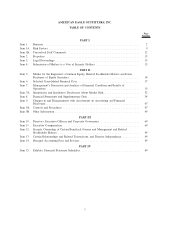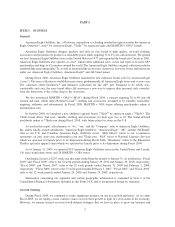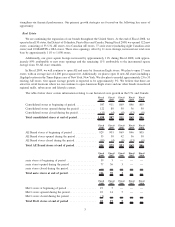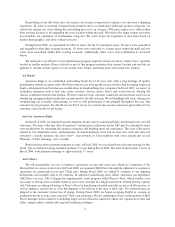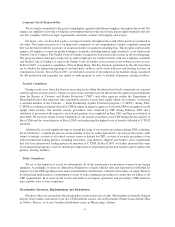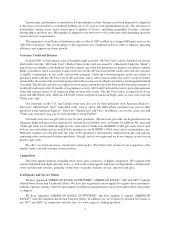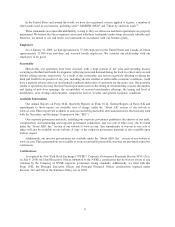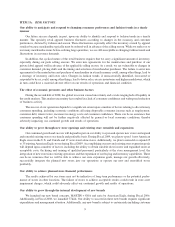American Eagle Outfitters 2008 Annual Report Download - page 11
Download and view the complete annual report
Please find page 11 of the 2008 American Eagle Outfitters annual report below. You can navigate through the pages in the report by either clicking on the pages listed below, or by using the keyword search tool below to find specific information within the annual report.ITEM 1A. RISK FACTORS.
Our ability to anticipate and respond to changing consumer preferences and fashion trends in a timely
manner
Our future success depends, in part, upon our ability to identify and respond to fashion trends in a timely
manner. The specialty retail apparel business fluctuates according to changes in the economy and customer
preferences, dictated by fashion and season. These fluctuations especially affect the inventory owned by apparel
retailers because merchandise typically must be ordered well in advance of the selling season. While we endeavor to
test many merchandise items before ordering large quantities, we are still susceptible to changing fashion trends and
fluctuations in customer demands.
In addition, the cyclical nature of the retail business requires that we carry a significant amount of inventory,
especially during our peak selling seasons. We enter into agreements for the manufacture and purchase of our
private label apparel well in advance of the applicable selling season. As a result, we are vulnerable to changes in
consumer demand, pricing shifts and the timing and selection of merchandise purchases. The failure to enter into
agreements for the manufacture and purchase of merchandise in a timely manner could, among other things, lead to
a shortage of inventory and lower sales. Changes in fashion trends, if unsuccessfully identified, forecasted or
responded to by us, could, among other things, lead to lower sales, excess inventories and higher markdowns, which
in turn could have a material adverse effect on our results of operations and financial condition.
The effect of economic pressures and other business factors
During the second half of 2008, the global recession caused uncertainty and a wide-ranging lack of liquidity in
the credit markets. This market uncertainty has resulted in a lack of consumer confidence and widespread reduction
of business activity.
The success of our operations depends to a significant extent upon a number of factors relating to discretionary
consumer spending, including economic conditions affecting disposable consumer income such as employment,
consumer debt, interest rates, increases in energy costs and consumer confidence. There can be no assurance that
consumer spending will not be further negatively affected by general or local economic conditions, thereby
adversely impacting our continued growth and results of operations.
Our ability to grow through new store openings and existing store remodels and expansions
Our continued growth and success will depend in part on our ability to open and operate new stores and expand
and remodel existing stores on a timely and profitable basis. During Fiscal 2009, we plan to open 11 new American
Eagle stores in the U.S. and Canada and 17 aerie stand-alone stores. Additionally, we plan to remodel or expand 25
to 35 existing American Eagle stores during Fiscal 2009. Accomplishing our new and existing store expansion goals
will depend upon a number of factors, including the ability to obtain suitable sites for new and expanded stores at
acceptable costs, the hiring and training of qualified personnel, particularly at the store management level, the
integration of new stores into existing operations and the expansion of our buying and inventory capabilities. There
can be no assurance that we will be able to achieve our store expansion goals, manage our growth effectively,
successfully integrate the planned new stores into our operations or operate our new and remodeled stores
profitably.
Our ability to achieve planned store financial performance
The results achieved by our stores may not be indicative of long-term performance or the potential perfor-
mance of stores in other locations. The failure of stores to achieve acceptable results could result in store asset
impairment charges, which could adversely affect our continued growth and results of operations.
Our ability to grow through the internal development of new brands
We launched our new brand concepts, MARTIN + OSA and aerie by American Eagle, during Fiscal 2006.
Additionally, in Fiscal 2008, we launched 77kids. Our ability to succeed in these new brands requires significant
expenditures and management attention. Additionally, any new brand is subject to certain risks including customer
9



